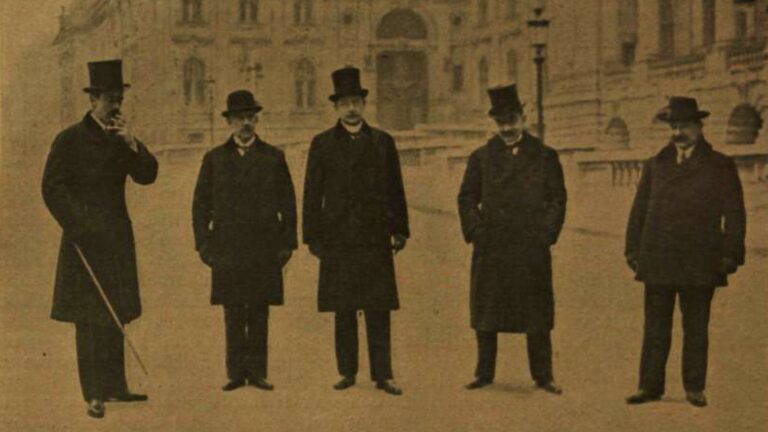The following is an adapted version of an article written by Lázár Pap, originally published in Hungarian in Magyar Krónika.
America—the new world, the land of opportunity, the land of the free. In the 19th and 20th centuries, hundreds of thousands of Hungarians left their former lives behind to cross the Atlantic and try their luck Far Far Away, that is, ‘Beyond the Óperencia’, as Hungarian fairy tales go. In its series, Magyar Krónika looks at the meeting points of America and Hungary through the Hungarian diaspora living in the US. In this part, let us continue the story of Béla Estván, who emigrated to the United States in the 1850s. The swindler, who pretended to be Hungarian in order to make it easier for himself to succeed in his new homeland, entered the service of Mexican Emperor Maximilian I after the American Civil War. His life, built on lies, finally collapsed in Vienna after blackmailing Franz Joseph I.
In 1864 Maximilian of Habsburg, Franz Joseph’s younger brother, sought to gain the Mexican throne with French support. However, Emperor Napoleon III’s assistance soon dried up, and US President Andrew Johnson, following the partial consolidation of the post-Civil War situation, sought to do everything in his power to end the French presence on the continent. They wanted to enforce the so-called Monroe Doctrine, which advocated non-intervention and neutrality. They wanted to enforce the so-called Monroe Doctrine, which advocated non-intervention and neutrality.
‘We owe it…to the cordial relations existing between the United States and these powers [the European great powers] to declare that any attempt to extend their system in the Western Hemisphere is a threat to our peace and security. We have not interfered in the affairs of the existing colonies of the European powers, and we do not intend to do so in the future either,’ President James Monroe’s 1823 address to Congress says.
‘It became apparent that the military and economic power of the North American state predestined it for superpower status’
The doctrine essentially formulated the following main demands towards the European great powers: the end of colonization of the New World, recognition of the newly independent Latin American states, and the abandonment of restoration efforts. In return, the United States respected the status quo, meaning it did not interfere in the affairs of existing colonies and kept itself out of European politics. Of course, at the beginning of the century, when the United States was not yet considered a great power, foreign countries did not attach much importance to the Monroe Doctrine. In the second half of the century, however, it became apparent that the military and economic power of the North American state predestined it for superpower status. The slogan ‘America for Americans’ sounded increasingly bad to the ears of Central and South American countries, as the United States announced its intention to lead the whole continent.
But as for Maximilian I’s Mexican expedition, in 1865, the United States began to support Mexican President Benito Juárez against Emperor Maximilian, who was aided by the French. In response, the Habsburg ruler resorted to propaganda and sought to have his northern neighbours recognize his rule. He established an agency in New York and appointed Louis de Arroyo as consul general of the Mexican Empire. It was at this point that Béla Estván became involved in the otherwise tragic story of the Mexican emperor. He visited Arroyo on several occasions and offered his services. The consul general recalled that he ‘gave the impression of being an influential man who spoke encouragingly about the chances of the empire being recognized’. Estván thus offered them what they desired, and he even managed to secure a personal audience with the emperor.
‘Although I had been away from my homeland for 17 years, I was still very attached to the imperial family of the House of Habsburg. I therefore seized the opportunity to serve an imperial prince indirectly, thereby attempting to repay my political debt to the Austrian ruling house, which I had accumulated over the past years,’ he said regarding his motivations. He suggested to his future clients that they pay off journalists and media outlets, using them to exert pressure on the government. Mexico’s new emperor bought into the plan and hired Estván for two years at a salary of 5,000 dollars, plus 40,000 dollars to cover his expenses. He had to arrange for the printing of various propaganda materials in New York and report on his activities every month. The latter, of course, was not to his liking, and he constantly insisted on being given a free hand in terms of spending.
‘We can rightly assume that Estván embezzled most of the funds intended for his mission’
Looking at his career, it is not surprising that he quickly spent the money entrusted to him. He opened offices in New York and Washington, hired assistants, and spent 40,000 dollars in a year. He then applied to the emperor for 35,000 dollars but ultimately received only 7,500. According to his account, he bribed three New York journalists and paid the editorial offices of The New York Herald, The New York Tribune, and The New York Times 750 each. Eventually, none of the three newspapers published pro-Maximilian articles—although the Tribune did publish a few articles sympathetic to the Mexican Empire, these were published more because of the newspaper’s anti-government stance. Overall, we can rightly assume that Estván embezzled most of the funds intended for his mission. In the end, the Mexican leadership broke off contact with him. However, this did not deter Estván. After Maximilian’s fall and execution in 1867, he published an open letter in The New York Times, which he signed as director of the Mexican Imperial Office in America. In his article, he condemned American neutrality and the Monroe Doctrine. He stated that his last task in the service of the emperor was to make a solemn protest to the American people, as our hero put it.
His career, however, did not end there, and although little is known about his subsequent activities, he spent time in London, St Petersburg, Berlin, and Paris. In 1872 he returned to Austria, where he sent a memorandum to Emperor Franz Joseph demanding 80,000 dollars from him. As he stated, this was what the late Emperor Maximilian owed him. However, this move did not remain without consequences, as the Austrian police arrested him on charges of fraud and embezzlement. In the end, his own brother revealed his true identity, and his life built on lies collapsed. In 1872 he was sentenced to six years in prison, and an Austrian daily newspaper reported on his trial. ‘A tall, rigid man with a short neck, a large head, a high forehead, thinning hair, and a grey beard,’ the author of the article wrote, who added that he had a ‘very pleasant, winsome personality’.
Questions still remain about Béla Estván’s life: for example, we do not know whether he fought in the Crimean War, whether he ever served in the Confederate Army, or whether he simply lied about the whole thing… In any case, according to István Kornél Vida, a researcher on the subject, his novel War Pictures from the South is an enjoyable read despite all the exaggerations. And his career, that is, his real one, clearly deserves to be brought to the big screen.
You can read about Béla Estván’s previous adventures in Part I.
This article is based on István Kornél Vida’s book From Világos to Appomattox.
Read the previous parts of the series below:
Click here to read the original article.







